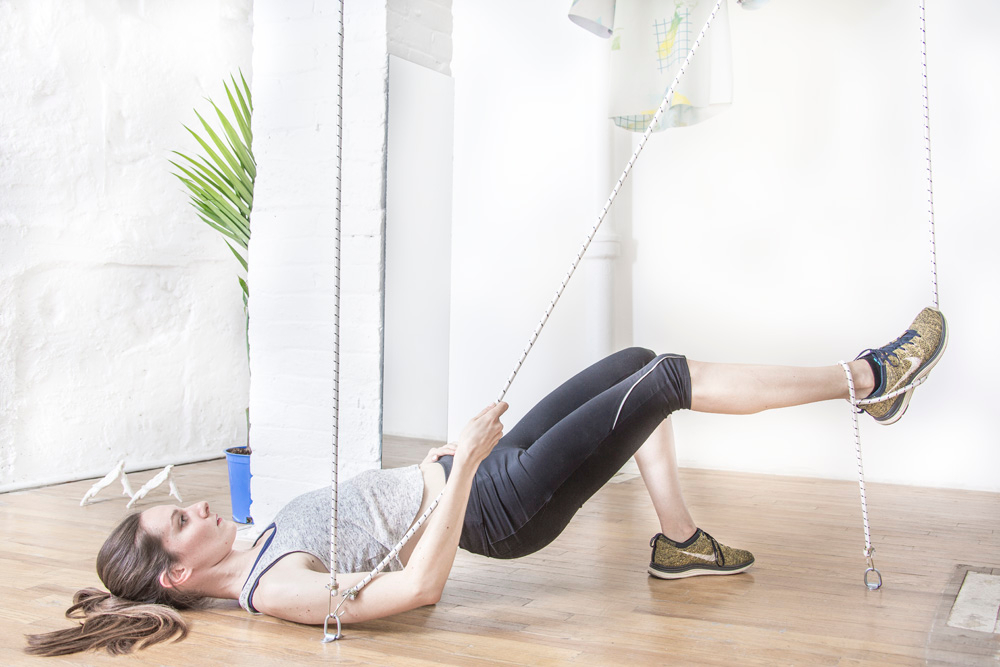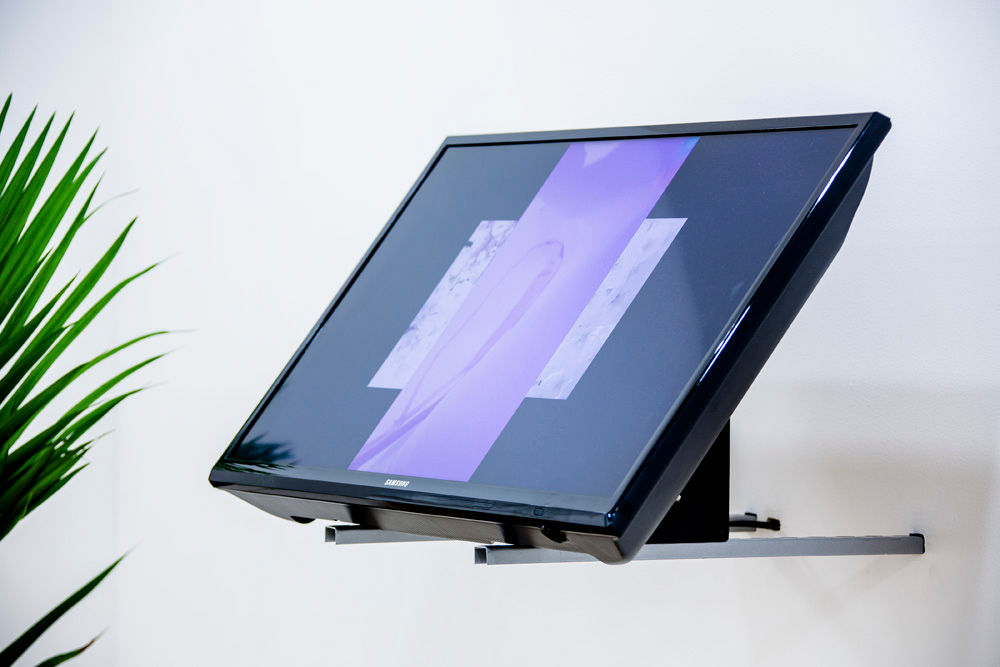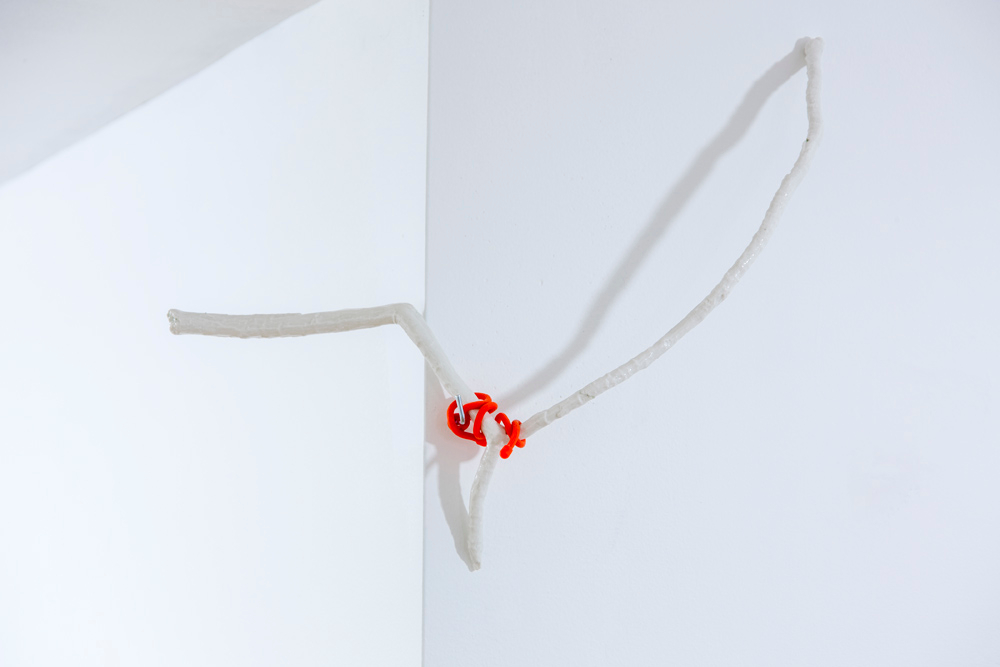
A duo of Lithuanian artists Neringa Černiauskaitė and Ugnius Gelguda have been working together since 2009. In their oeuvre – which includes video pieces, objects, photos – they use things and materials that, having shed their original raison d’être in this world, enter novel political, cultural, and economic contexts. On 26 June, the pair opened an exhibition in Vilnius’ Contemporary Art Centre, The Metaphysics of the Runner. CAC curator Inesa Pavlovskaitė talks to the artists.
Inesa Pavlovskaitė: Your latest project The Metaphysics of the Runner has a different aesthetic and theme than your previous works, projects like Now More Than Ever (Lietuvos Dailė 2012, CAC), Reflection Wood Chronicles (2012), In the Highest Point (2011). In your latest work, visionary mood comes to substitute the retroactive gaze: signs of the past give way to those of exponential technological advancement, posthumanist presentiments. The past-present dialectic is replaced by the present-future one. What instituted this turn, if this is indeed a new direction in your work? How significant were the last few years that you spent in New York City?
Neringa Černiauskaitė: I’d have to start by saying that it seemed to us too that this was a huge break with what we did before. However, having reflected once more on the themes that had interested us in our previous work, we realized that the current project actually carried on with the same question of the relation between imagination and future. What interests us is the gap between imagination, the present and the future. For example, In the Highest Point analyzed how the future was imagined back then. In fact, we are now living in the future that was merely imagined at the time. In Reflection Wood Chronicles, the [Europe] Park and its sculptures were used as a background for post-history, we tried to imagine, using cinematic means, how these sculptures would appear to the eyes of future people, i.e., used by them as picnic sites or shelters from rain. New York made a huge impact on our work, as Vilnius had before. The city itself, its omnipresent advertising as well as dominant artistic currents did influence our aesthetic.
Ugnius Gelguda: New York artists reflect a great deal on the situation of the city, everything around them. Interestingly, there’s a direct connection linking exhibitions and galleries, each show is a turn in the dialogue, indiscernible though it might be to a naked eye.
I.P.: The city is a favorable environment for launching and following aesthetic and ideological trends.
N.Č.: Indeed, and what we do is not so much reflecting on these trends as continuing, taking part in them.
I.P.: Thinking of the context of your new exhibition, what comes to mind are artists like Pamela Rosenkanz, Timur Si-Qin, Josh Kline. These artists take noticeable interest in latent synergy of human body and technology and its consequences. In your show too, it seems, you focus on prosthesis, extending the body, the relation of the organic and the technological. You mostly employ synthetic materials, there are many references to a “clash” of technology and the body. Could you comment on the structure of the show and how it relates to these aspects?
U.G.: We are creating an installation that replicates the structure of a gym. The elements we use remind rather clearly of the familiar structures used in the gym and everyday life: railings, etc.
N.Č.: Yes, structures that extend the body, used to help hold our balance, lean against, etc. When you take away all of their details and functions, these generalized motifs from exercise machines turn into abstract minimalist sculptures, a little ironic, since they presuppose active use, stretching and bending. There are also screens that are usually found on treadmills, simulating landscapes and urging one to keep running – when you stop, the screen shuts down and the reality you were running from all along sets in. You are running in order to evade that reality.
U.G.: In creating the object of a garment, something we collaborated on with the New York-based artist Jeannine Han, we attached great significance to selecting a synthetic fabric. She wanted to laser-cut a motif or two in the garment, but she couldn’t because of the toxicity of the fabric. A piece of clothing turns into an object, it is not worn.
N.Č.: The sculpture of a runner is made of resin, while molds of the branches from Central Park are porcelain. At the same time, it is hard to distinguish porcelain and resin. The materialist aspect is very important indeed.
I.P.: Twenty-first-century advances in science, technology, digital communication and information technologies bring essential changes to aspects of the human environment, body and language. Could we speak of the recurring runner’s motif as a metaphor for the millennial person? It seems that speed is a defining aspect of her condition.
N.Č.: This is our self-portrait (laughs). We call ourselves the long distance runners.
U.G.: The Soylent drink exhibited in a 321 Gallery in Brooklyn was not just an object, it was a necessity for us. We didn’t have time for anything, so preparing food or thinking about food was a burden. The perfect Soylent mix, which frees you from thinking about physiological aspects, had much to recommend itself, so it became part of the exhibition.
N.Č.: It’s interesting how physical speed becomes an obstacle for making money in high frequency trading (HFT). We talk of the speed of light between motherboard servers and the share trading Algobit algorithm which makes predictions about the trade. The further it is from the motherboard, the longer it takes for data to come, losing a tenth of a millisecond – in contrast to those that are closer. Physical parameters simply prevent you from trading faster than you could. Once upon a time it was people with phones, who would close and open their eyes very slowly, there are loads you could do in that fraction of a second. Physical speed is a nuisance for capital flow. Technology, which we make in order to keep producing, plays a great role in this. Speed must overtake itself in order to become something else. The metaphysics of the runner is about pushing forward, exceeding yourself, stepping into post-organics, consuming additives.
I.P.: Extending the body.
N.Č.: Yes, and replacing it. Bringing the body and the world into sync. Bernard Stiegler says that it’s in the human nature, we were born into technology, our memory is prosthetic, we exist only by using external devices.
I.P.: Art historian Alexander Alberro, who recently gave a lecture in Vilnius, employed the notion of speed to describe the contemporary art recipient. According to him, it’s someone who’s super fast.
N.Č.: I think it has also to do with the way we experience art shows. Just flip through the pages of Contemporary Art Daily or Mousse. In New York City, there are several institutions that meticulously photograph a show and publish the images even before it opens. It’s a flat experience, sometimes perfectly sufficient. We can see five exhibitions in one swipe on our touch screen, take them in and draw inspiration.
I.P.: It’s noteworthy that your own exhibition documentation plays into such a strategy, your shows become mediated. In The Metaphysics of the Runner exhibition that you held in Brooklyn, you invited a model to document it, someone who animated the exposition. One photo got included into the show in Vilnius.
N.Č.: Yes, it was our intention to reveal how documenting is a form of deceiving. It’s not an objective gaze.
U.G.: Looking at magazines like Mousse, etc., you notice that, over the last three years, there has been a qualitative change in documenting exhibitions. They employ tricks not unlike those in advertising – additional lighting, etc. – in order to make a painting look impeccable, even though it might not have looked like that in reality.
N.Č.: Moreover, documentation removes the human body. What we get is an idealized image for a person who does not participate. There’s only the eye that “walks” across the screen. This is exactly the viewer that such shows are intended for. Speaking of the links between commerce and art, interestingly, the prevailing view is that real things, things that are experiential, are true and resist commerce. Is such a view naive? It reveals reluctance to admit that these experiences are just as commodified. Those who engage in obvious production at least are open and frank about it. This amounts to active adoption of capitalist strategies in an attempt to somehow change or critique it instead of allegedly resisting it while in fact fully participating therein. The distinction here is between active and reflexive action. We would prefer to highlight the active one. An ad in an art exhibition might seem irritating to the eye for many. It’s like you come to have a break from advertising, from commercial clichés, but it’s exactly what you find here. Adopting this aesthetic is a conscious move, so we can speak the same language rather than engaging in abstractions and distancing ourselves from all that. Doing things instead of talking.
I.P.: The Metaphysics of the Runner was presented differently in the 321 Gallery in Brooklyn and NADA art fair in New York, and now in Vilnius. Do you think there’s a difference – and if so, what is it – in your show’s reception here and back there? Your previous oeuvre, which was shown here, was rather tightly anchored in the local (collective) memory, cultural history, something that allowed both the empathic and analytical gaze, whereas The Metaphysics of the Runner uses a language that, it seems to me, is less amenable to direct suggestion, your preoccupation with the influences and effects of new technology is not as relevant or talked about in our public sphere as, say, in the United States.
N.Č.: I think that has to do with the generation gap. People who run the Nike marathon will readily understand what we are talking about. The exhibition is about and with the generation that was born digital. A generation that does not fear the future, does not fear speed but, rather, accelerates it. We do realize that parts of the audience will find it very foreign, yet, we hope, still interesting, something they’d want to oppose, that will not leave them indifferent. The show will, perhaps help elucidate how different generations relate to the future, to one another. For instance, contemporary children are better at using technology than their parents – and that has implications for education, for the school, where teachers seem to be afraid of interactive screens and pupils mock them about it. What we’re talking about is the fall of authority. An interesting issue to consider.
U.G.: Moreover, the exhibition here will take a completely different form than the one in Brooklyn, where it was more site-specific, adapted to the space and the light. Thus our choice of a less traditional documentation for that show – a female athlete demonstrated how different elements work in that space, that they’re more than just lines.
N.Č.: Granted, some elements of the exhibition in New York are to be read directly. Simply because they are part of someone’s everyday life. But also because of the intensity of the artistic field. One’s eye is used to this kind of aesthetics, materiality, it’s easily readable and recognizable. Things that might seem matter-of-course there can stand out here a little, but, on second thought, this discrepancy itself is of considerable interest. It is more than clear, though, that similar processes take place here as well – we talk about post-internet sculpture, everything is in the air, all it takes is an explosion. For me, the Nike marathon is the best proof that the phenomenon we talk about in our exhibition is global. Thanks to technological and corporate incorporation, everyone is now a global citizen.
I.P.: Alexander R. Galloway defines contemporary capitalism as computerized capitalism; according to him, the same impact that the assembly belt and steam engine made on the course of history, is now effected by software. Your exhibition contains many references to the corporate culture: logos, merchandise aesthetic, etc.
N.Č.: The future is clearly linked to particular trademarks. Nike is part of your life and you stop looking at it as an enemy-logo, but incorporate it instead. The Art in America magazine has recently published a series of stories titled just so: “Incorporated Minds” or “Incorporated Aesthetics”. Those born into the capitalist system do not see it as something external any more. There’s no such thing as the external at all. Whatever you do, you’re always in relation with it. That’s what we’re talking about. Moreover, some of the pieces in the show talk about their own branding. We’re toying with an idea to create a brand for ourselves, because it’s becoming increasingly clear how much that would ease communication. Adopting the brand strategies is an artistic practice. There’s a photo in our exhibition with a logo digitally removed – and this provides space for our own brand, perhaps in the next The Metaphysics of the Runner show.
I.P.: What links your previous and current artistic practices, I think, is the running motif of utopia or, rather, dystopia. When you reflect on the future in your current exhibition, your starting point, in part, is the singularity theory by the US scientist and futurist Ray Kurzweil, who says that, in 2045, people and machines will merge. It seems that the vision for the future in your show is a threatening one, even apocalyptic. Is it so?
U.G.: There’s this concept of post-irony. The video piece where we use sounds made by Kurzweil’s synthesizer is quite ambivalent. Each sound carries an ominous vision, Drone Harmonics is very sad, but at the same time it contains wittiness of sorts, the sounds are as much ominous as they are witty.
N.Č.: I wouldn’t say it’s utopia or dystopia – it’s absolutely realist. Preparing very rationally for a future; an anthropocentric “mess-up” that we now have to deal with. It’s clearly pragmatic and perhaps less utopian. Kurzweil himself reflects on the future very pragmatically, he sets out a clear-cut program. Kurzweil’s future holds little promise of anything good. Humans will be a backward species. His visions help re-evaluate what a human being is, what we call human and what we are reluctant to call human. In order for Kurzweil’s projections to come true, we need to come up with positive definitions of human. The issue at hand is very slippery. Positive definitions are dangerous, too. We know from history what definitions of human being, race, etc. can amount to. Our relation with technology becomes increasingly integrated, sharp, technology comes to help us define ourselves: what I am, what I’d like to preserve and what I’d like to give up.
I.P.: Thank you for the interview.
* Courtesy of Alex Ross
The interview was originally published on 7 meno dienos, NR. 25 (1086), 2014-06-27
See photo reportage from The Metaphysics of the Runner at Contemporary Art Centre, Vilnius here.

The Metaphysics of the Runner, 2014. Exhibition view at 321 Gallery, Brooklyn, New York. Photo: Daniel Terna, model: Stephanie Harris

The Metaphysics of the Runner, 2014. The Metaphysics of the Runner, 2014. Exhibition view at 321 Gallery, Brooklyn, New York. Photo: Daniel Terna, model: Stephanie Harris

The Metaphysics of the Runner, 2014. The Metaphysics of the Runner, 2014. Exhibition view at 321 Gallery, Brooklyn, New York. Photo: 321 Gallery

The Metaphysics of the Runner, 2014. The Metaphysics of the Runner, 2014. Exhibition view at 321 Gallery, Brooklyn, New York. Photo: 321 Gallery

After Nature, 2014. Video, iPhone video footage, 3D graphics, 3:54 min. Video still

Untitled (Porcelain. Central Park), 2013. Porcelain, 8 x 26 cm. Exposition view at 321 Gallery, Brooklyn, New York, 2014

After Effects, 2014. Video, 3D graphics, sound: K-200 Kurzweil synthesizer, 0:36 min. Video still

The Metaphysics of the Runner, 2014. Exhibition view at 321 Gallery, Brooklyn, New York. Photo: Daniel Terna, model: Stephanie Harris

The Metaphysics of the Runner, 2014. Exhibition view at the Contemporary Art Centre (CAC), Vilnius. Photo: Ugnius Gelguda






























